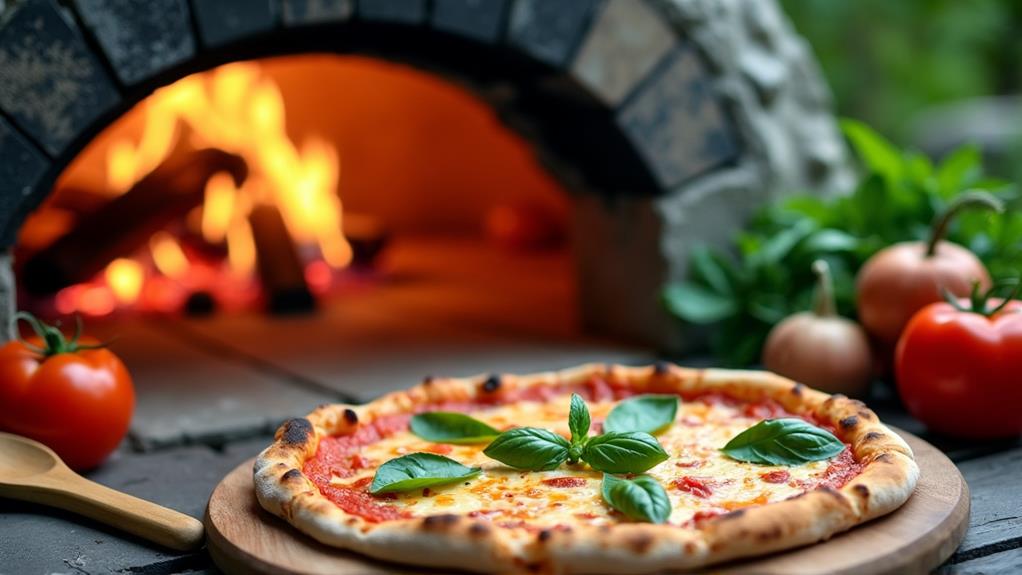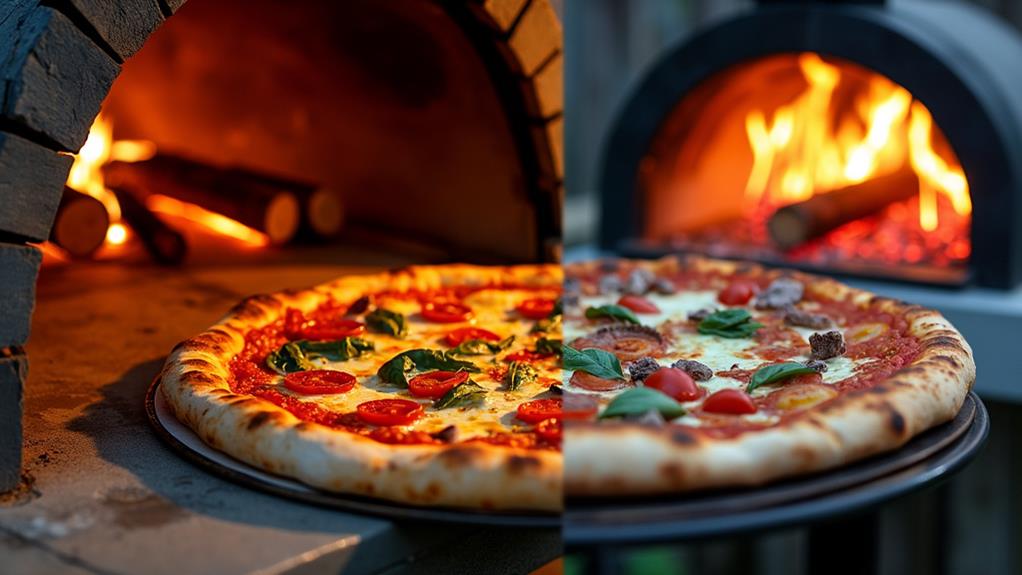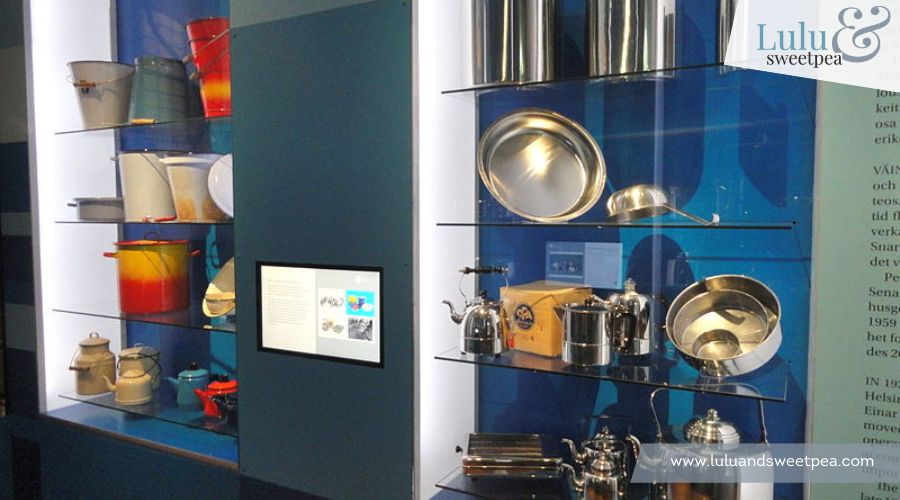Top 10 Tips for Perfect Pizzas in a Charcoal Pizza Oven
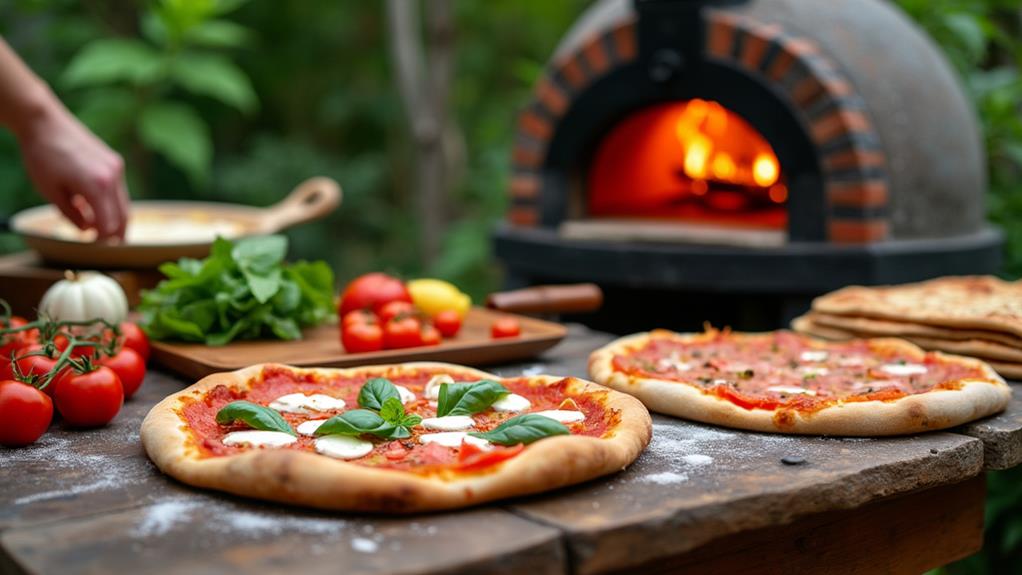
Mastering pizza in a charcoal oven requires precision and technique. Start by preheating your oven to the ideal range of 800°F-900°F for a perfect crust. Use high-quality, low-moisture ingredients, and stretch your dough gently.
To achieve a crispy crust, avoid overloading it with toppings. Additionally, rotate your pizza and pay attention to visual cues for even cooking.
Interested in more tips to elevate your pizza-making skills?
Preheat Your Oven
Before you start making your perfect pizza, preheat your charcoal oven for at least 30 minutes to guarantee it reaches an ideal 800°F to 900°F. This high heat is vital for achieving the crispy crust that defines a great pizza.
Arrange your coals in a C-shape along the back of the oven to ensure even heat distribution. These high temperatures are crucial for cooking pizza effectively, allowing the dough to rise quickly and the toppings to cook perfectly without burning.
Skipping this step or not reaching the right heat level can result in a soggy crust and unevenly cooked toppings.
To enhance the flavor, consider adding wood chips to the coals during preheating. This infuses your pizza with a delightful smoky aroma that elevates the overall taste.
Avoid typical barbecue coal setups; instead, focus on creating a concentrated heat source. This method ensures that your charcoal oven maintains the high temperatures needed for authentic pizza cooking.
Now, you're set for the next steps in creating your pizza masterpiece!
Monitor Temperature Accurately
To ensure your pizza bakes perfectly, use an infrared thermometer to measure the stone's temperature, aiming for 700°F to 900°F. Preheat the stone thoroughly by placing it on the grill as the coals ignite. Adjust the airflow to manage any temperature fluctuations and maintain consistent heat.
Use Infrared Thermometer
An infrared thermometer is essential for achieving the perfect baking temperatures in your charcoal pizza oven. This device precisely monitors the oven temperature, ensuring your pizza stone is hot enough for optimal cooking. Aim for a stone temperature between 700°F and 1,000°F, with the overall oven temperature ideally between 800°F and 900°F.
By using an infrared thermometer, you can quickly and accurately measure the surface temperature of your pizza stone without opening the oven. This is crucial because opening the door causes heat loss, affecting cooking efficiency. Simply point the thermometer at the pizza stone to get an instant reading, helping you maintain the high heat needed for a crispy crust and evenly cooked toppings.
Regularly check the oven temperature, as fluctuations can occur due to environmental factors or opening the oven door. Monitoring these changes allows you to adjust your charcoal or airflow to maintain the perfect heat.
This way, your oven remains consistently hot, ready to bake perfect pizzas every time.
Preheat Stone Thoroughly
For the perfect pizza, thoroughly preheating your stone is vital to achieving that coveted crispy crust. A properly preheated stone guarantees even heat distribution, fundamental for cooking your pizza evenly and avoiding a soggy base.
Aim to preheat the stone to around 550°F to 900°F, depending on the pizza style you're crafting.
To ensure the surface temperature is just right, use an infrared thermometer. This handy tool helps you accurately monitor the stone's heat, ensuring it reaches the ideal temperature before you launch your pizza.
Don't rush this step; allow the stone to preheat for at least 30 minutes. This ensures that the heat is evenly distributed across the entire cooking surface, giving you a perfectly crispy crust every time.
Avoid the mistake of placing your pizza on a cold stone, as this will result in uneven cooking and a disappointing, soggy crust.
Regularly check the temperature of your oven and make adjustments as needed to maintain consistent heat.
Adjust for Fluctuations
Maintaining a consistent temperature in your charcoal oven is crucial for cooking the perfect pizza due to the rapid cooking times at high temperatures. To ensure your oven reaches the ideal range of 800°F to 900°F, use an infrared thermometer for precise temperature monitoring. This tool helps you detect any fluctuations that could impact your cooking.
Heat loss often occurs at the front of the oven, so consider using a vented door to maintain even heat distribution throughout the cooking process. Regularly check and adjust the arrangement of coals to ensure the heat is evenly spread. Uneven heat can cause your pizza to cook unevenly, resulting in an imperfect crust.
External factors such as wind and ambient temperature can also affect your oven's performance. Be prepared to make frequent temperature checks and adjustments.
Remember, pizzas typically cook in under two minutes at high temperatures, so quick reactions are essential to avoiding burns. By incorporating these tips to monitor temperature closely and adjust for fluctuations, you can guarantee every pizza you bake is cooked to perfection.
This approach will help you master the art of creating delicious pizzas in your charcoal oven.
Prepare Ingredients in Advance
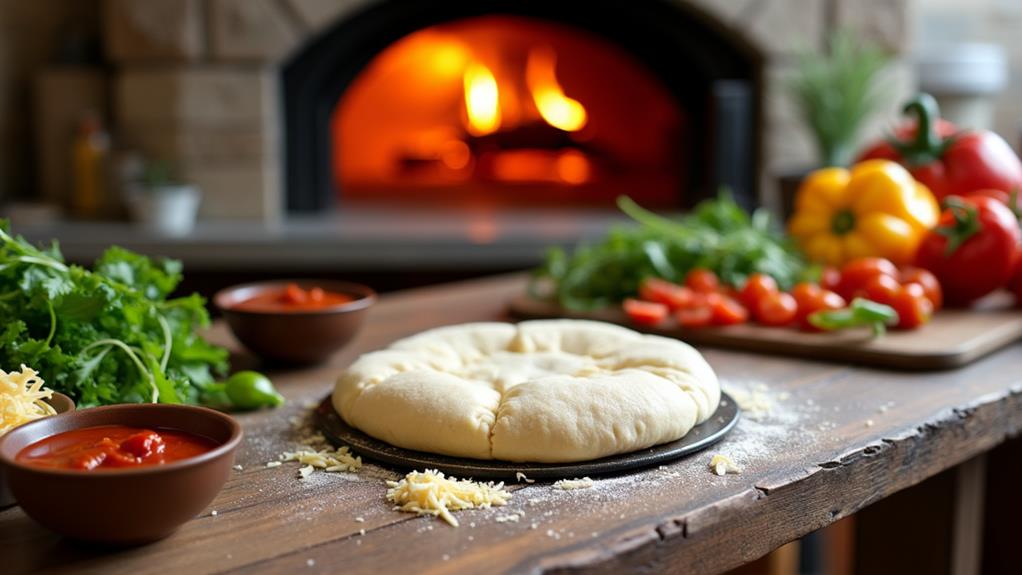
When it comes to making perfect pizzas in a charcoal oven, preparing your ingredients in advance is crucial. High-temperature charcoal pizza ovens cook pizzas incredibly fast, often in as little as 90 seconds, so you need to be ready to assemble quickly.
Start by ensuring all your toppings are pre-measured and within easy reach. This not only streamlines the process but also keeps you organized, allowing you to focus on creativity rather than scrambling for ingredients.
Using fresh, high-quality ingredients significantly enhances the flavor and appearance of your pizza. Pre-slicing vegetables, grating cheese, and draining high-moisture toppings like canned tomatoes can prevent a soggy crust and improve your pizza's texture. Opt for low-moisture cheese varieties to further safeguard against unwanted moisture.
Organizing your workspace is another vital factor. Have all your tools—like pizza peels, cutters, and brushes—within arm's reach. This setup reduces stress and makes the pizza-making process enjoyable and efficient.
Use the Right Flour
Once your ingredients are prepped and your workspace is organized, the next crucial step is choosing the right flour for your pizza dough. The type of flour you use significantly influences the texture and flavor of your pizza. For a chewier crust, 00 flour is ideal, while bread flour offers added strength. High-protein flours, with a protein content of 12-14%, yield a chewier and more elastic dough, perfect for the high-heat environment of a charcoal pizza oven.
Here's a quick breakdown of different types of flours and their uses:
| Flour Type | Protein Content | Ideal For |
|---|---|---|
| 00 Flour | 12-13% | Chewy, Neapolitan-style |
| Bread Flour | 12-14% | Strong, elastic dough |
| All-Purpose Flour | 10-12% | Softer crust, lower heat |
| Gluten-Free Flour | Varies | Dietary restrictions |
| Whole Wheat Flour | 13-14% | Nutty flavor, dense texture |
It's important to note that lower-protein flours, like all-purpose flour, can produce a softer crust but may not hold up well under high temperatures, potentially resulting in a soggy base. For those with dietary restrictions, gluten-free flour blends are available, though they might require additional binding agents to achieve the right dough consistency. By selecting the appropriate flour, you set the foundation for a perfect pizza baked in your charcoal oven.
Proper Dough Handling
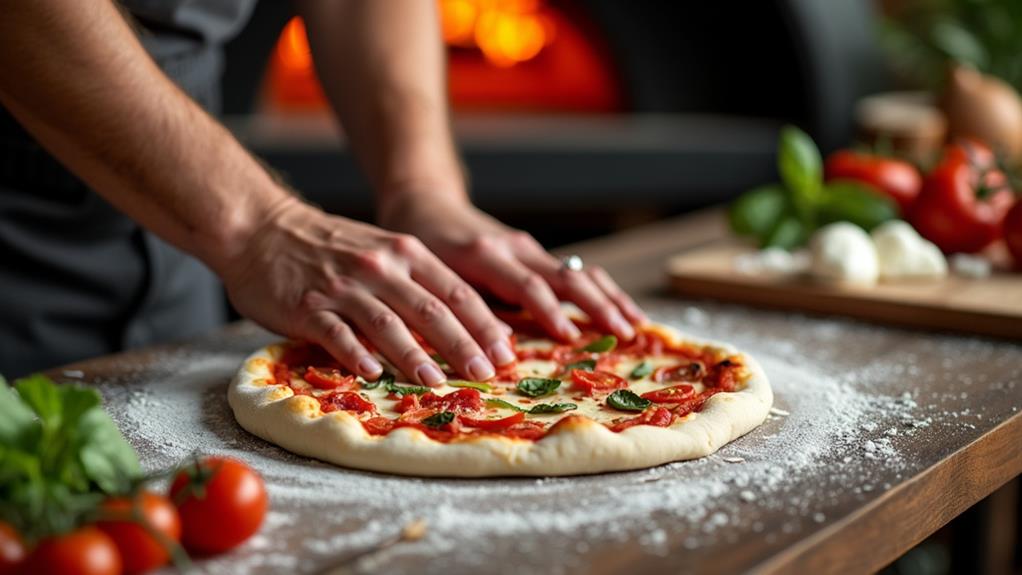
Proper dough handling is essential for achieving the perfect texture and structure in your pizza. Begin by allowing your dough to rest at room temperature for at least 30 minutes. This relaxation period lets the gluten loosen up, making the dough easier to stretch without tearing.
When you're ready to shape the dough, use a generous amount of flour on your hands, work surface, and pizza peel. A 50/50 mix of rice flour and white flour works best to prevent sticking to the peel.
As you stretch the dough, inspect it for any holes. Even small holes can compromise the structure during baking, so pinch them closed. Gentle hand-stretching is key; avoid pressing the dough into pans to maintain an airy texture.
To transfer your pizza quickly and smoothly, utilize the "hovercraft technique." Lift one edge of the dough and blow air underneath to reduce friction. This will help you work quickly and avoid sticking issues.
Proper dough handling ensures your pizza transfers from peel to oven without compromising its integrity. Follow these steps, and your oven will yield perfect pizzas every time.
Optimal Loading Techniques
Mastering optimal loading techniques is essential for achieving perfect pizzas in a charcoal oven.
Begin by dusting your pizza peel with a blend of rice flour and white flour to prevent the dough from sticking, facilitating a smooth transfer onto the baking stone. Stretch the pizza dough slightly smaller than the oven's diameter to avoid tearing and ensure easy placement.
Ensure the charcoal oven is preheated between 700°F and 900°F for a crispy crust and evenly cooked toppings. To launch the pizza, use a swift backward motion to maintain its shape and prevent the toppings from sliding off.
Keep the pizza peel level and steady as you slide the pizza onto the hot baking stone, executing the motion swiftly yet smoothly to avoid mishaps.
With these techniques mastered, you're on your way to creating perfect pizzas every time. Now that your pizza is in the oven, let's move on to the next step to ensure even cooking.
Rotate for Even Cooking
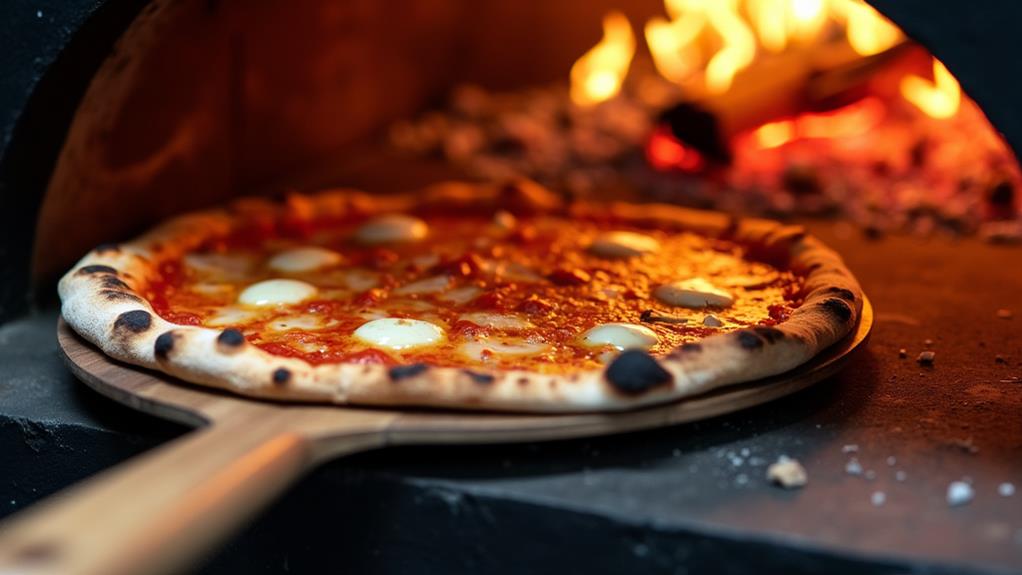
For even cooking in a charcoal oven, rotate your pizza every 10 to 20 seconds. Use a smaller turning peel for easy quarter turns, monitoring the crust's color and texture. Allow the crust to set briefly before rotating to maintain its shape and achieve perfect results.
Consistent Rotational Technique
If your charcoal pizza oven produces uneven heat, regularly rotating your pizza every 10 to 20 seconds ensures even cooking. Establishing a consistent rotational technique is crucial for a perfectly cooked pizza.
By closely monitoring the pizza and rotating it at regular intervals, you prevent one side from burning and achieve an evenly cooked crust and toppings.
To master this technique, use a smaller turning peel, which allows you to make smooth quarter turns without disturbing the pizza's structure.
Begin by positioning the pizza away from the flame to cook evenly, then move it closer for final browning. This method ensures the entire pizza is exposed to a consistent temperature, promoting uniform cooking.
Timing and Positioning
For a perfectly cooked pizza in a charcoal oven, timing and positioning are crucial. Begin by placing your pizza away from direct flames to ensure even heat distribution, which allows the crust to set without being exposed to intense heat.
To achieve uniform browning and prevent burning, rotate the pizza every 10 to 20 seconds. Use a small turning peel for precise quarter turns, ensuring all parts of the pizza receive equal heat exposure. Keep a vigilant watch on the cooking process, as cooking times can range from 1 to 6 minutes depending on your oven's temperature and the pizza's thickness.
Here's a quick reference table:
| Action | Timing | Purpose |
|---|---|---|
| Initial Positioning | Away from flames | Uniform heat distribution |
| Initial Rotation | After 10-20 seconds | Prevent burning |
| Subsequent Rotations | Every 10-20 seconds | Even cooking |
Avoid Overloading Toppings
When making the perfect pizza in a charcoal oven, it's crucial to avoid overloading toppings. Too many toppings can lead to a soggy crust, as excess moisture from high-moisture ingredients overwhelms the dough during cooking.
To ensure a balanced topping ratio, aim to limit your toppings to about 4-5 ounces per pizza. This helps maintain the structural integrity and cooking efficiency of your pizza.
Here are four key tips to avoid overloading your pizza:
- Use well-drained ingredients: Ingredients like fresh mozzarella should be drained well to minimize moisture content and prevent the pizza from becoming too heavy.
- Lightly spread sauce: Avoid excessive pooling of sauce to prevent it from seeping into the crust and hindering its crispiness.
- Balance your toppings: Spread toppings evenly and avoid piling them too high to maintain a balanced topping ratio.
- Improve flavor with less: A lighter approach to toppings enhances overall flavor and allows for better heat circulation in the oven, resulting in a more evenly cooked pizza.
Monitor Cooking Time
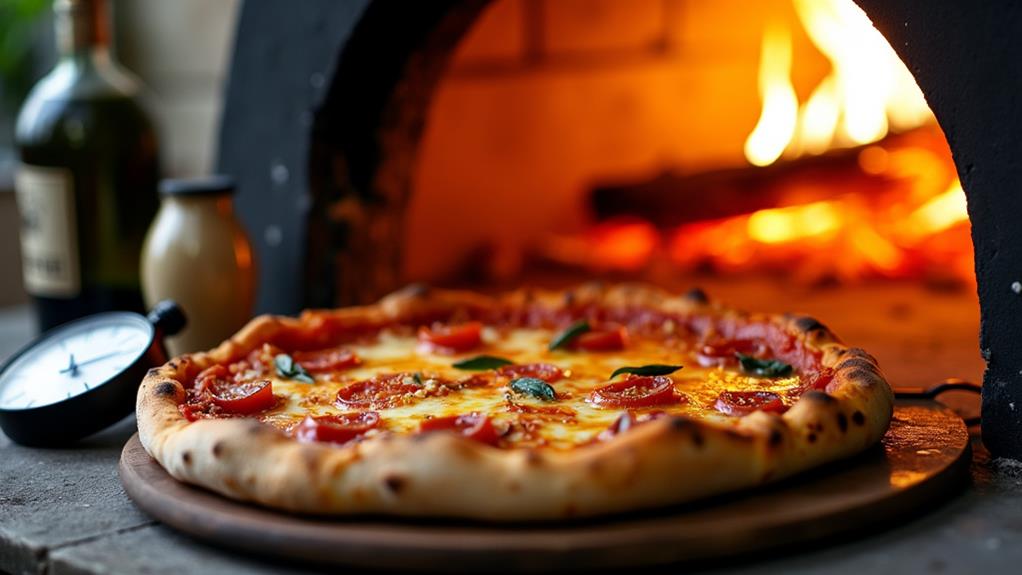
To achieve the perfect pizza, it's crucial to monitor your cooking time closely. With oven temperatures ranging from 550°F to 900°F, pizzas cook quickly, often between 1 to 6 minutes. Keep a close watch to prevent burning. Rotate your pizza every 10 to 20 seconds for an even bake, and use an infrared thermometer to maintain a consistent temperature.
Optimal Pizza Cooking Time
Achieving the perfect pizza in a charcoal oven requires careful attention to cooking time and temperature. Generally, pizzas cook within 5 to 7 minutes, but this can vary depending on the oven temperature and crust thickness.
To ensure your pizza is cooked to perfection, follow these steps:
- Check the Temperature: Use an infrared thermometer to measure the surface temperature of your pizza stone. Ideal cooking temperatures range from 550°F to 700°F.
- Rotate the Pizza: Every 1 to 2 minutes, rotate the pizza to ensure even cooking and prevent over-charring on one side.
- Monitor Visual Cues: Look for bubbling cheese and a golden-brown crust as indicators that your pizza is almost ready.
- Time It Right: Set a timer for the cooking duration, but also rely on visual and temperature cues to guide you.
Preventing Pizza From Burning
As your pizza cooks in the charcoal oven, it's crucial to monitor it closely to prevent burning. Charcoal ovens can reach extremely high temperatures, typically between 700°F and 900°F, so using an infrared thermometer to check the cooking surface temperature is essential. This helps you achieve the perfect balance between a crispy crust and well-cooked toppings.
To avoid burning, rotate the pizza every 20 seconds. This ensures even cooking and prevents one side from receiving too much direct heat from the coals. Frequent rotation stops specific areas from charring while others remain undercooked.
Proper positioning also plays a significant role in preventing burns. Place your pizza in the center of the oven or further back from the heat source to avoid direct flames. This minimizes the risk of burning the crust or toppings.
Lastly, rely on visual cues to determine when your pizza is ready. Look for bubbling cheese and a golden-brown crust. Setting a timer for 1 to 3 minutes and checking these indicators will help you perfect your pizza without burning it.
Adjusting for Even Bake
To achieve an evenly cooked pizza in a charcoal oven, close monitoring is essential as cooking times can range from 1 to 7 minutes, depending on the oven temperature and pizza thickness.
Follow these steps for the best results:
- Rotate Every 30 Seconds: Rotate the pizza every 30 seconds to ensure even browning and prevent burning on one side, especially at high temperatures.
- Check Surface Temperature: Use an infrared thermometer to check the cooking surface. Aim for a temperature between 700°F and 900°F.
- Position Away From Direct Flame: Place the pizza away from direct flame to achieve a crispy crust without burning.
- Adjust for Environmental Factors: Be mindful of environmental factors such as wind and ambient temperature, which can affect your oven's heat retention and may require adjusting cooking times.
Enjoy the Process
Diving into the world of charcoal pizza ovens is an exciting adventure, where each attempt brings you closer to mastering the craft. The most important thing to remember is to enjoy the process.
Making homemade pizza is about more than just the end result; it's about the journey, the laughter, and the memories created along the way.
Embrace the learning curve that comes with using a charcoal pizza oven. Each attempt, whether a success or a failure, offers valuable lessons.
Experiment with different toppings and styles, letting your creativity shine. You might discover a unique, delicious combination that becomes a household favorite.
Sharing your pizza-making experiences with friends and family can foster a sense of community. The aroma of cooking pizza and the crackle of the charcoal add to the overall enjoyment, making the process as delightful as the finished product.
Celebrate each homemade pizza as a personal achievement. It doesn't have to be perfect—the joy of cooking and sharing food is what truly matters.
Take a moment to appreciate your efforts and savor the experience. Enjoying the process is what'll make each pizza special.
Conclusion
Mastering the art of making perfect pizzas in a charcoal pizza oven involves several key steps. Start by preheating your oven thoroughly. Handle your dough with care to ensure it's not overworked, and avoid overloading your pizza with toppings to prevent sogginess. Rotate the pizza regularly for even cooking, and closely monitor the temperature and cooking time. Most importantly, enjoy the process and feel free to experiment with unique ingredients. With practice, you'll be crafting delicious, crispy pizzas consistently. Happy pizza making!

